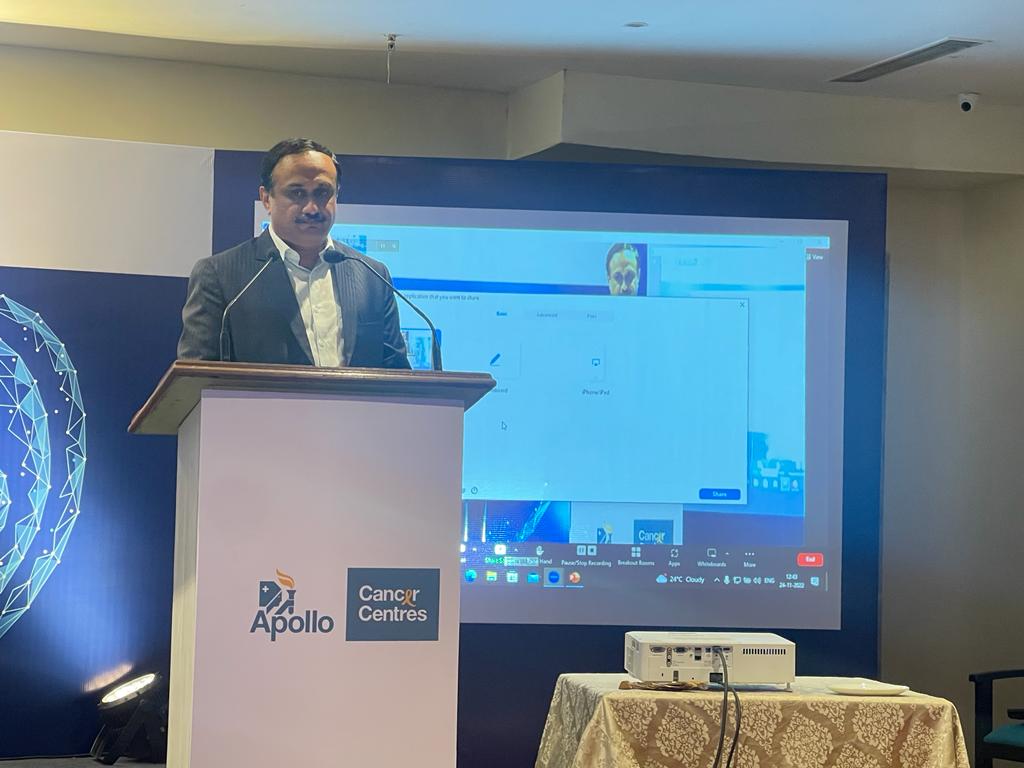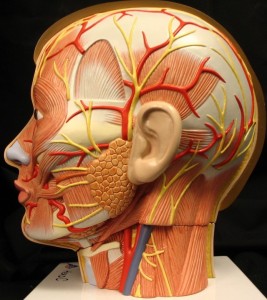Apollo Cancer Centre is the first hospital to perform a minimally invasive surgery to remove facial nerve schwannoma.

Dr Satish Nair, senior consultant, Apollo Cancer Centre, Bengaluru, announcing the success of the world's first endoscopic transcanal excision of facial nerve schwannoma. (South First)
The facial nerve schwannoma, a rare, slow-growing but benign tumour, most commonly occurs between the ear and the brain — a complex region when it comes to surgery.
Which is why doctors at Bengaluru’s Apollo Cancer Centre were elated when they successfully removed the tumour of a 35-year-old Tanzanian diplomat in an operation that, for the first time ever, used a combination of three different surgical techniques.
Apollo Cancer Centre thus became the world’s first hospital to perform what is called an “endoscopic transcanal excision”, a minimally invasive way to excise facial nerve schwannoma.
“Normally, such a tumour is removed by making an incision behind the ear, pulling the ear forward, and drilling the bone behind it to expose the nerve,” said Dr Satish Nair, senior consultant, ENT & Head and Neck Oncology, while announcing the surgery’s success on Thursday, November 24.
“The advantage of endoscope is that it can go directly through the ear into the canal. However, a microscope needs to be opened up to reach the area,” Dr Nair explained.
“For the first time in the world,” he said, “we applied the principles of head and neck, lateral skull-based approach, and endoscopic techniques together.”

Representational picture of facial nerve schwannoma. Apollo Hospital in Bengaluru performed the world’s first endoscopic transcanal excision of FNS. (Supplied)
The facial nerve controls all of the muscles of the face — from the blinking of eyes to the muscles that help with speaking, smiling, etc. It is also the only nerve which exits the brain and comes into the neck through a bony canal in the ear.
“The nerve passes through multiple areas. It goes in between the balance area, hearing area of the ear, into the ossicles (three bones in either middle ear that are among the smallest bones in the human body) and comes out into the skull base,” Dr Nair said.
“Any weakness to this nerve means weakness to one side of the face. A patient cannot smile or talk properly.”
A tumor engulfing the nerve in this compact area which controls so many functions of the body makes it an extremely complicated case.
“This is a rare tumour, but once it starts affecting and producing effects in these areas, it can cause problems in hearing, weakness of face, and cause permanent damage. Hence it has to be operated,” the doctor explained.
The 35-year-old woman from Tanzania — an advocate and a diplomat with a busy career and an active social life — had been suffering from right-side facial weakness for the past two years. After going to doctors in several parts of the world, she finally approached the Apollo Cancer Centre in Bengaluru.
“She was diagnosed as a case of facial nerve schwannoma with mild facial weakness and hearing loss. Our team did an endoscopy that revealed a pinkish-pale-pulsatile mass,” said Dr Nair.
“The patient had right-sided Grade V lower motor neuronal facial palsy and a mass in the facial recess eroding the posterior genu of the facial nerve, which suggested the facial nerve schwannoma.”

The Apollo Cancer Centre team which performed the world’s first facial transcanal excision for facial nerve schwannoma. From left Dr Asha, senior consultant, Dr Satish Nair, Dr Manish Mattoo, CEO, Apollo Hospitals, Karnataka Region; and Dr Savith Kumar. (South First)
The immediate challenge the doctors faced was deciding how to excise the tumour.
Especially as the patient was clear that she did not want any post-surgery scars — she did not want her social and professional life to be affected in any way. She wanted her hearing back, and wanted to get on with activities she loved, such as swimming.
The usual procedure adopted for surgically removing facial nerve schwannoma — involving incision and drilling — tends to leave a scar. Also, in an open surgery, as the ossicles are removed, any water-related activity is ruled out as the ears are expected to be kept covered at all times.
“Again, the patient wanted to fly back soon after the surgery. In most surgeries, it is not permitted to take a flight for at least two to three weeks. So this was a challenge too,” Dr Nair said.
More than the patient-imposed challenges, however, the location of the tumor was in itself the bigger challenge, said the doctor.
“However, with the expertise I had in performing endoscopic surgeries, I decided to do a endoscopic transcanal excision for this case,” said Dr Nair.
.The endoscopy method helped the doctors directly reach the tumor area and remove it with no “cavity”.
Reaching the tumor with no cuts not only means in a faster recovery, but also a complete restoration hearing. And unlike the usual method, there are no post-surgery restrictions on their daily activities.
“It was a tough surgery. But with our expertise and technique we were able to pull off the world’s first endoscopic transcanal excision of facial nerve schwannoma.
“The surgery lasted two hours and patient was discharged the same evening. She flew back to her country and her hearing was restored after seven days,” Dr Nair said.
As the tumor that was removed and was not cancerous, the chances of the tumour re-emerging are practically zero. The patient has, however, been advised to get an MRI scan after a year to check status.